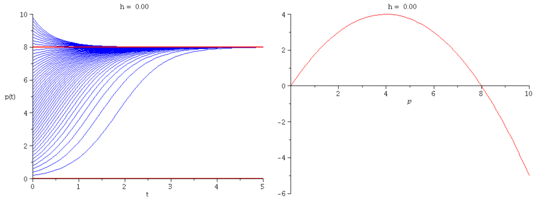

|
|
Project 4 is on a study of the dynamics of a single species population. Thomas Robert Malthus and Pierre-François Verhulst are the originators of the mathematical modeling of population growth. You will find their biographies in Wikipedia, and oodles of information about their population models by searching the web for “malthus, population” and “verhulst, population”.
Malthus' An Essay on the Principle of Population was published in 1798. The book's full title, characteristically of the 18th century, is quite long: “An Essay on the Principle of Population, as it affects The Future Improvement of Society. With Remarks on the Speculations of Mr. Godwin, M. Condorcet, and Other Writers.” Wikipedia has an analysis and summary of the book.
Verhulst's article Notice sur la loi que la population suit dans son accroissement was published in 1838. An English translation exists but I don't have it and don't want to spend $40 to get it. The first page, however, is available for free:
A note on the law that a population follows in its growth
by P.-F. Verhulst
It is known that the celebrated Malthus established as a principle that the human population tends to increase according to a geometric progression, so as to double after a certain period of time, for example, every twenty-five years. This proposition is incontestable, if one neglects the ever increasing difficulty of procuring supplies when the population has acquired a certain degree of agglomeration, or the resources which the population uses in its growth, even when the society is still nascent, such as a greater division of labor, the existence of a regular government and means of defense which insure the public tranquility, etc.
In effect, all things being equal in other respects, if a thousand souls have become two thousand after twenty-five years, these two thousand will become four thousand after the same lapse of time.
In our old European societies, where the fertile land has been cultivated for a long time, the work needed to improve a field already under cultivation can add little to its productivity, admitting that, in the first twenty-five we double the production of the soil, in the second period barely succeed to make it produce a third extra. The growth of the population is therefore limited by the size and fertility of the country, and the population tends, therefore, to become more and more stationary.
The free part of the translation ends in the middle of the previous paragraph. I completed the paragraph with some help from Google Translate.
Here is an idea: If you are comfortable with French, why don't you try to translate more of that article? If you do, I will add it to this page with due credit.
Here are ideas for your report but you are not limited to these:
Aside: Here is how one writes
Pierre-François Verhulst in LaTeX:
Pierre-Fran\c{c}ois Verhulst.
“Equilibrium” is a singular noun. You may say: “This equation has one equilibrium point.” Or: “This equilibrium point is stable.”
“Equilibria” is the plural of “equilibrium”. You may say: “This equation has many equilibria.” Or: “These equilibria are stable.”
Actually, “equilibria” is Latin for “equilibriums”. If in doubt, replace “equilibria” with “equilibriums” in your sentence and see if the result makes sense.
I solved Verhulst's differential equation with harvesting for a variety of initial conditions and harvesting rates and produced the animation in Maple. I exported it as a multiframe GIF image, and further processed the individual frames using ImageMagick's command-line tools.

The January 2013 Washington Post article titled A desperate try to restock the Potomac’s sturgeon says that the Potomac river's once most plentiful fish, the sturgeon, was last seen in 1970. Overfishing is to blame.
The October 2009 Baltimore Sun article titled Black bear hunting season begins in Md says “The state has set a target of 60 to 85 bears in Garrett and Allegany counties for the season.” This corresponds to setting h = 60 or 85 in our project.
The June 8, 2010 article in examiner.com titled Black bears expanding across Maryland tells a brief history of black bears in Maryland, gives some statistics on their population, and provides advice on what to do when you come across one.
The Maryland Department of Natural Resources (DNR) has quite a bit of interesting information on Maryland black bears on its website. See, for instance, Black Bear in Maryland and Bears Harvested During 2015.
This January 2008 story from Baltimore Sun titled Countdown to crab harvest tells about how the Maryland Department of Natural Resources goes about estimating the size of the crab population in the Chesapeake Bay.
Preliminary 2009 salmon data released by the Pacific Fishery Management Council shows a continuing decline in the adult return of Sacramento River Fall Chinook. … This is the lowest recorded return since comprehensive monitoring of Central Valley Hatchery production and natural escapement began in the 1970s.
You will find quite a bit of additional information on this if you google for “chinook sacramento”.
\bib{malthus-1798}{book}{
author={Malthus, Thomas Robert},
title={An Essay on the Principle of Population},
publisher={J. Johnson in St.~Paul's Church-yard},
place={London},
date={1798},
}
\bib{verhulst-1838}{article}{
author={Verhulst, P.-F.},
title={Notice sur la loi que la population suit dans son accroissement},
journal={Correspondance Math{\'e}matique et Physique},
place={Ghent},
date={1838},
volume={10},
pages={113--121},
}
| Author: Rouben Rostamian |
|